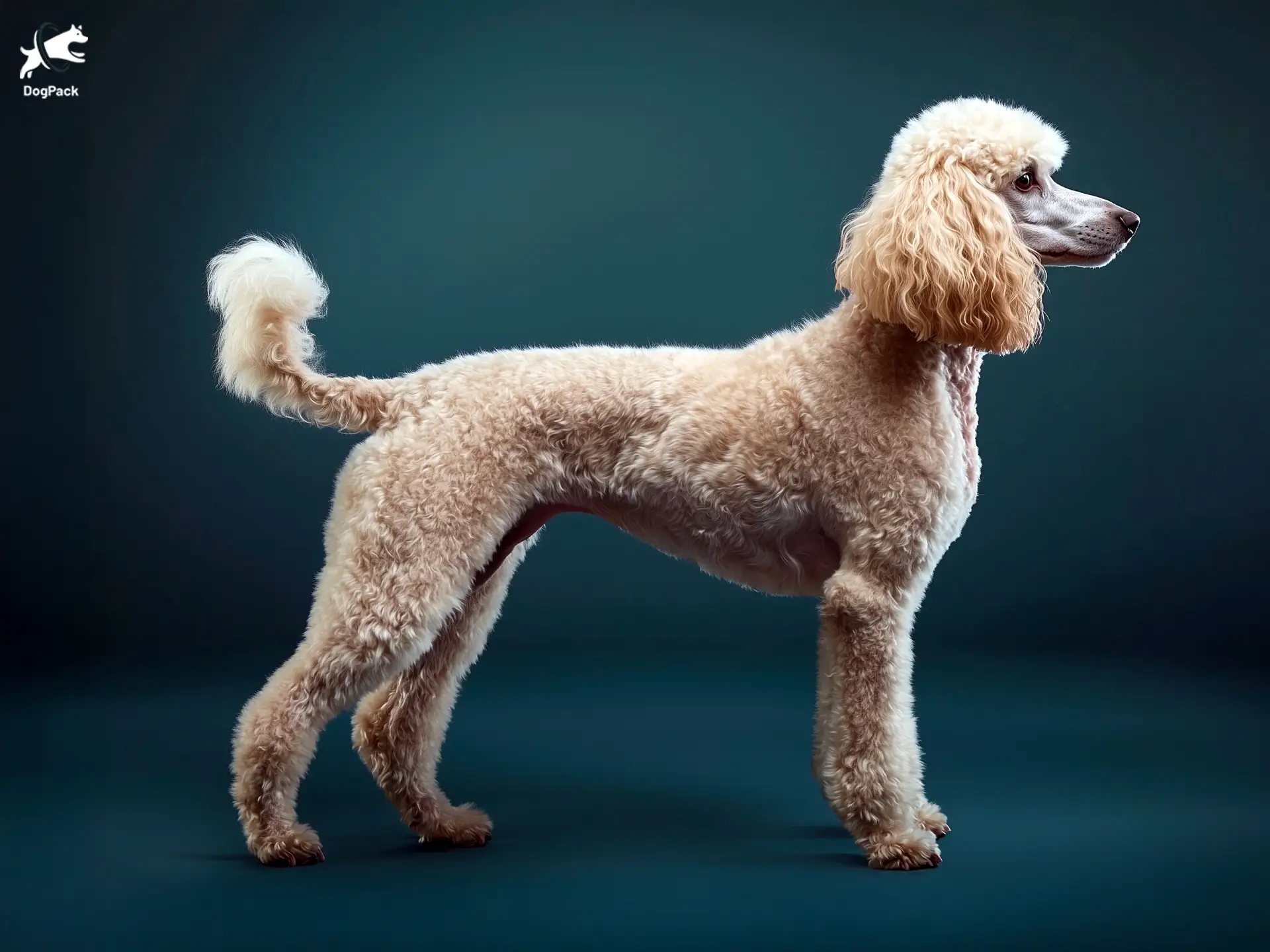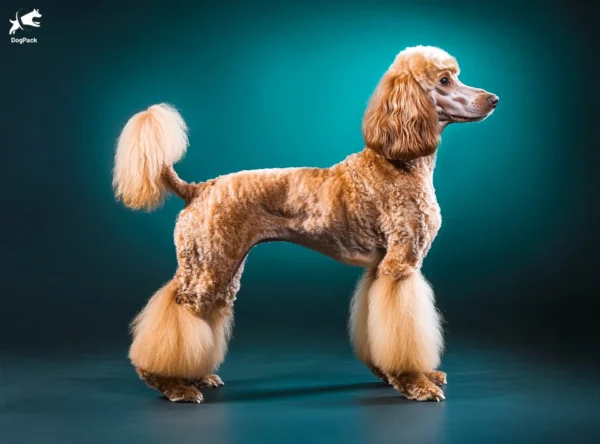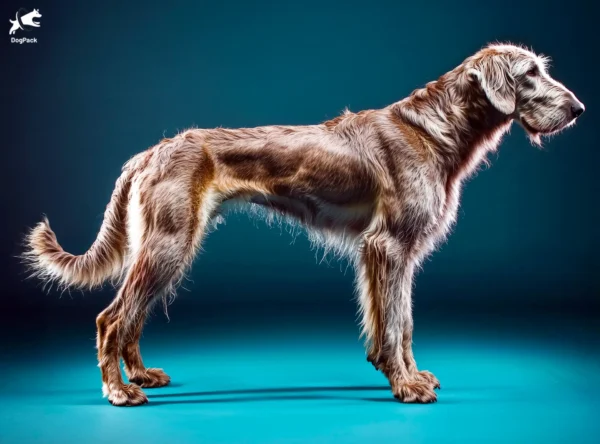Royal Poodle Dog Breed Info & Overview
Often called the “giant” among Poodles, the Royal Poodle stands above the rest in both size and stature—though it’s not officially recognized as a distinct variety. Renowned for an elegant build, high intelligence, and a curly coat, these regal canines can adapt surprisingly well to family life. Expect a loyal, affectionate companion with a flair for the dramatic.
Characteristics
Pictures
Breed History
Most experts trace this oversized variation back to the Standard Poodle’s roots in Germany, where “Pudel” referred to water-retrieving dogs. Over time, breeding for impressive size produced the Royal Poodle, although no major kennel club formally recognizes it as separate. In France, Poodles of all sizes enjoyed aristocratic status, but the biggest versions helped hunters retrieve larger game in chilly marshes.
Show circles later popularized the biggest Standard Poodles for dramatic grooming styles. Owners discovered that these imposing dogs retained the same sharp intellect and agility as their smaller cousins. While formal registries still group them under the Standard category, many enthusiasts affectionately label bigger specimens as “Royals” to celebrate their grand appearance.
Despite debate over official classification, the Royal Poodle remains a favorite among those who love a commanding canine presence. Early owners showcased these dogs in circuses and street acts for their trainability and flair. Though flashy clips garnered attention, their true value lay in steady temperaments and quick problem-solving skills—attributes that persist in modern members of this striking subset.
Temperament, Personality
A Royal Poodle typically exhibits self-assured poise and keen intelligence. While their size might be intimidating, they’re known for an affectionate, friendly demeanor—especially when socialized early. They often develop a deep loyalty toward family members and delight in mental challenges like trick training or puzzle toys, making them fun companions for households that want an interactive dog.
These larger-than-life canines can be watchful around strangers, occasionally barking at unexpected sights or sounds. However, once they sense no threat, they welcome new friends with surprising warmth. When given ample attention, they respond with unwavering devotion. Families appreciate this balance of protective instinct and playful energy, which can shift from guard duty to goofy antics in a heartbeat.
Left to their own devices for too long, they might resort to restless behaviors or nuisance barking. Structuring daily playtimes, training sessions, and social meet-ups helps them stay mentally stimulated. With the Royal Poodle, expect a dog that reads the room quickly—adapting to your mood yet always ready for a lively game of fetch or a long cuddle on the couch.
Physical Characteristics
Standing taller than standard-sized cousins, the Royal Poodle flaunts an imposing build balanced by graceful lines. Despite their larger frame, they maintain the same trademark Poodle coat—dense, curly, and low-shedding. Whether clipped in a sporting trim or more elaborate styles, they turn heads everywhere they go, with colors ranging from solid black or white to striking partis and phantoms.
Long legs, a proud chest, and an elegant neck define this dog’s silhouette. Like all large dog breeds, they benefit from sturdy joints and well-developed muscles—especially crucial for supporting their extra height. A Royal Poodle’s muzzle is typically elongated, with dark, oval-shaped eyes that reflect keen awareness. Floppy ears frame a face that’s both noble and eager.
While “Royal” remains an unofficial label, many breeders select for bigger bone structure and taller stature. Despite the imposing form, they remain agile and light on their feet. This contrasts with some giant breeds that can appear lumbering. In motion, a Royal Poodle often strides with the same buoyant gait seen in the show ring, radiating confidence every step of the way.
Health Issues
Like all Poodles, the Royal variety can be prone to hip dysplasia, a condition where the joint forms improperly. Their heavier weight makes early detection critical, so regular orthopedic checks are advised. Eye health screenings are also essential to catch progressive retinal atrophy and cataracts before they worsen. Genetic testing helps reputable breeders reduce these risks.
Another issue to watch for is bloat (gastric torsion), especially in larger-chested dogs. Feeding smaller, frequent meals instead of one big serving can help, alongside limiting strenuous exercise immediately after eating. Royal Poodles may also experience Addison’s disease, requiring lifelong medication to manage hormonal imbalances. Staying attuned to subtle changes in energy or appetite can reveal early signs of illness.
Routine vet exams, balanced diets, and mindful exercise regimens keep these dogs thriving. Joint supplements—like glucosamine or fish oil—may offer extra support for aging hips and elbows. Don’t overlook dental care, as gum disease impacts overall well-being. Informed owners who prioritize preventative measures typically enjoy many active years with these captivating oversized companions.
Grooming Needs
Sporting the same hypoallergenic coat type as smaller Poodle relatives, the Royal Poodle demands a thorough grooming schedule. Expect salon visits every four to six weeks for trims, as their dense curls grow continuously. Daily or every-other-day brushing prevents tangles and mats, which can form quickly if neglected—especially in plush areas like the ears and chest.
Bathing frequency varies, but once every month or two suffices for most dogs, unless they romp through muddy terrain. Select shampoos formulated for sensitive skin, as Poodles can develop irritations if products are too harsh. Careful ear cleaning is crucial to ward off infections, since their floppy ears trap moisture. Trimming nails regularly also helps large dogs stay comfortable.
A well-groomed Royal Poodle not only looks magnificent, but also benefits from healthier skin. Routine brushing disperses natural oils, keeping the coat shiny. For owners with allergies, consistent grooming can minimize dander around the home. While the grooming regimen is time-intensive, many find it a rewarding bonding experience—plus, these dogs love the pampering and attention.
Exercise Requirements
Plan for daily walks, energetic play sessions, or even runs alongside a bicycle to meet this dog’s activity needs. Given their size, they can easily topple furniture if bored indoors. Channeling their natural athleticism into games like fetch or canine sports—such as obedience competitions—helps keep them mentally and physically sharp. These pursuits also strengthen your relationship.
Because they stem from water-retrieving stock, swimming often comes naturally. If you have access to a safe pond, lake, or dog-friendly pool, your Royal Poodle may relish a good splash. For land-based alternatives, puzzle toys and advanced trick training provide mental stimulation. A morning hike or afternoon agility course suits their intelligent yet playful personality.
Vary the routine to prevent monotony. One day might involve a brisk neighborhood walk followed by a short jog; another, a romp at the dog park. Keep sessions age-appropriate—puppies shouldn’t overdo it, as excessive high-impact exercise can strain developing joints. With the right balance of physical and mental engagement, this regal pup remains content and well-mannered at home.
Training Tips
As a highly intelligent dog, the Royal Poodle responds best to consistent, upbeat training methods. Harsh techniques can backfire, creating anxiety or stubbornness. Short sessions packed with treats, praise, or a favorite toy keep them motivated. Early obedience work sets the tone, preventing them from using their size to nudge or pull owners around.
These dogs excel at advanced commands, from rally obedience to complex tricks like retrieving named objects. Regularly challenge them with new tasks so they don’t outsmart you out of boredom! Introducing them to various people, pets, and environments during puppyhood fosters a confident demeanor. Proper socialization curbs excessive wariness or protectiveness.
Because of their watchful nature, guard barking can become an issue if left unchecked. Teaching a clear “quiet” command and rewarding calm behavior is key. Mental puzzles—like hide-and-seek with treats—cater to their problem-solving flair. Patience and positive reinforcement yield a respectful companion who stays eager to learn, no matter how big they grow.
Nutrition, Diet
Royal Poodles typically consume around 3–4 cups of high-quality kibble per day, split into two meals. Aim for formulas that list real meat as the first ingredient, plus moderate fat levels for sustained energy. Look for recipes containing chondroitin or glucosamine to support joint health, especially given their larger frame.
Puppies benefit from diets labeled for large-breed growth to ensure the correct balance of calcium and phosphorus. Overfeeding can cause rapid weight gain, placing undue stress on developing joints. Monitor portions closely—feeling slight rib definition is a good indicator of healthy weight. For added nutrition, incorporate safe fruits like blueberries or veggies such as green beans into their meals.
Due to the breed’s susceptibility to bloat, avoid vigorous play right after mealtime and consider using a slow-feed bowl to reduce gulping. If you opt for fresh or raw diets, consult a veterinary nutritionist to confirm essential nutrients. By tailoring feeding schedules and content to a Royal Poodle’s specific needs, you’ll nurture a robust, shining dog from puppyhood onward.
Adoption, Breeders
Those seeking this unique variation can explore Standard Poodle rescues first, as larger Poodles occasionally appear in shelters. Websites such as Petfinder or the Poodle Club of America rescue listings often feature adoptable dogs labeled “oversized” or “Royal.” Adopting can be especially rewarding if you’re ready to welcome an adult dog with established traits.
For those intent on a puppy, reputable breeders should provide health clearances for hips, eyes, and other genetic concerns. Ask to meet the mother, and if possible, the father to gauge temperament and size. True Royal Poodle breeders will disclose that this is an unofficial designation. They focus on producing robust, well-socialized pups prepared for family life.
Steer clear of sellers who prioritize “gigantic size” over health or a stable disposition. Research thoroughly, read testimonials, and request references from past clients. Ethics matter as much as looks. A conscientious breeder or rescue group ensures you’ll take home a healthy companion that won’t outgrow your couch—or your expectations—unprepared.
Family Pet?
Despite their towering appearance, these dogs can be gentle giants when raised with children. They often adapt their energy level to younger family members, either romping in the yard or settling for a comforting presence. Supervision is key for very small kids, as an excited Royal Poodle can accidentally knock them down in play.
Many owners praise their empathetic nature and ability to read household moods. Friendly yet discerning, they’ll greet visiting friends with curiosity, especially if introduced calmly. Because they love attention, they rarely stray far from their beloved humans. This ingrained loyalty translates into an excellent watchdog: protective enough to raise an alarm, but far from aggressive by default.
Families living in houses with sufficient space—indoors and out—tend to find these dogs are a perfect fit. They thrive on being included in daily routines, whether it’s a movie marathon or a brisk walk at sunrise. Paired with consistent boundaries, the Royal Poodle blossoms into a reliable companion who adores kids and adults alike.
Right For You?
If you’ve got room in your heart and home for a significantly sized pup, the Royal Poodle could be your match. Their sharp intellect demands mental stimulation and training variety. Owners who appreciate grooming and can handle the upkeep will find their curly coats rewarding. That said, prepare for an active schedule—these dogs thrive when both body and mind are engaged.
A giant Poodle might not be ideal for those in tight apartments or with minimal time for walks and brushing. Although they can adapt surprisingly well, consistent care is non-negotiable. Busy professionals who can’t invest in daily mental enrichment may struggle. On the flip side, experienced dog lovers who want a large, hypoallergenic pet will relish the companionship this breed offers.
Ultimately, the Royal Poodle suits families, retirees seeking an attentive friend, and couples who desire a luxurious yet active pet. With proper effort in training and grooming, they’ll repay you with unwavering affection and comedic charm. Carefully consider your lifestyle, space, and budget to ensure you can meet this oversized Poodle’s needs—then prepare for a lifetime of curly devotion.
Conclusion
Standing tall among other Poodle varieties, the Royal Poodle offers an impressive blend of intelligence, elegance, and gentle spirit. Though not officially recognized as a separate breed, many enthusiasts cherish these extra-large Standard Poodles for their distinctive presence and endearing nature. From obedient family guardian to playful backyard clown, they excel in diverse roles as long as you devote the time and care they crave. If you’re drawn to a dog that’s equal parts showstopper and loyal friend, the Royal Poodle might be your perfect match.
FAQs
-
How do I socialize a Royal Poodle if they’re wary of strangers?
A Royal Poodle benefits from controlled introductions in neutral locations. Offer treats or praise when they stay relaxed. Gradually expose them to various people, sounds, and settings, keeping each encounter positive.
-
Does a Royal Poodle’s larger size affect agility performance?
Your Royal Poodle can still excel at agility with proper conditioning. Their height and leg length may require gentle introduction to jumps and tunnels. Focus on gradual training to avoid joint strain.
-
Are Royal Poodles harder to groom than Standard Poodles?
They’re essentially the same breed with bigger frames, so the grooming routine is similar—just on a larger scale. A good slicker brush, regular trims, and consistent coat checks keep them looking polished.
-
What kind of living space suits a Royal Poodle best?
Although they adapt to smaller homes, a yard is ideal so they can stretch their legs. Daily exercise is crucial. As long as they have ample walks, mind games, and training, apartment life is still possible.
-
Is it easy to find Royal Poodle puppies from ethical breeders?
They’re less common than standard-sized pups, so research is key. Look for breeders who emphasize health clearances and strong temperaments. Always verify references and meet the parent dogs if possible.
Breed Ratings
The Royal Poodle learns commands swiftly, thriving on mental challenges and problem-solving tasks.
With ample energy and a love for games, they enjoy regular fetch, tug-of-war, and puzzle toys.
While spirited, they can adapt to moderate exercise regimens, provided they get consistent daily outings.
Like other Poodles, they have a low-shedding coat but need consistent brushing to prevent mats.
Originally water retrievers, they may chase smaller animals but typically respond well to focused training.
Although they don’t shed much, the sizable coat calls for frequent trims and diligent upkeep.
Highly receptive to positive reinforcement, they often master advanced tricks and competitive obedience tasks.
These social dogs can become bored or anxious if left alone too long. Routine interaction is vital.
Alert and watchful, they’ll sound off at new sights or noises, though training can moderate excessive barking.
Drool is minimal, keeping cleanup relatively simple compared to many large breeds.
Generally amiable with other canines, especially when socialized from puppyhood.
Proper care and health screenings help them live robust lives, though joint issues and bloat are concerns.













